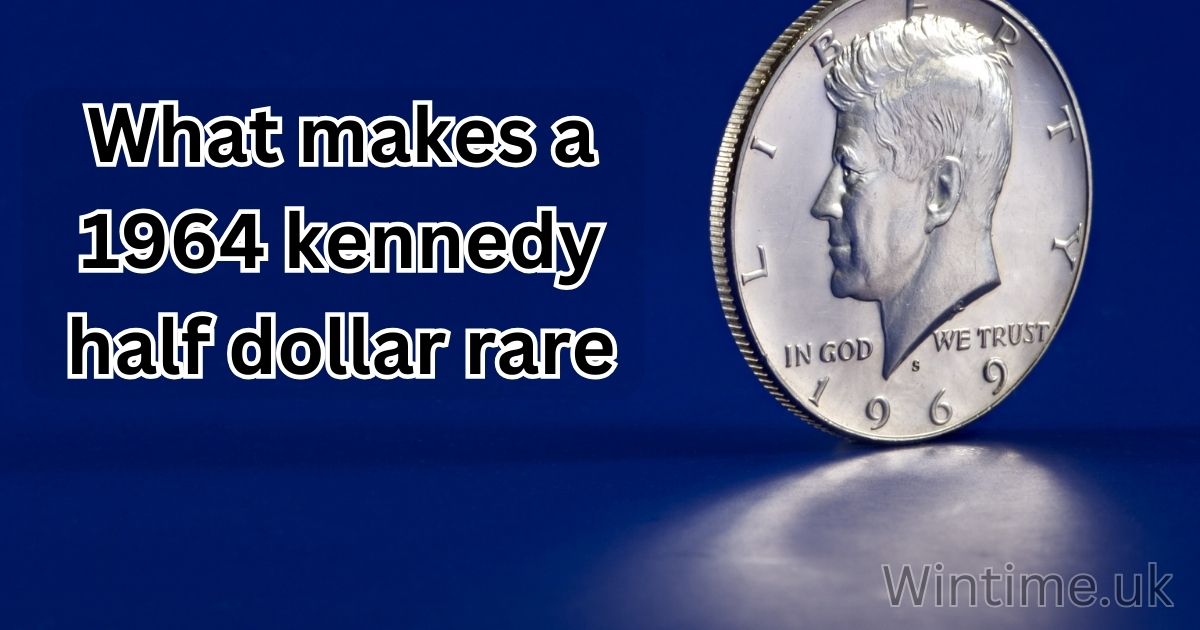The 1964 Kennedy Half Dollar stands as a significant piece in American numismatics, capturing the interest of coin collectors and history enthusiasts. This coin, issued to honor President John F. Kennedy after his assassination, has become a highly coveted collectible. Understanding what makes a 1964 Kennedy Half Dollar rare involves exploring its historical background, minting details, and the factors influencing its rarity and value. This guide aims to reveal the elements that make this coin so special, shedding light on why it remains a standout item in the world of coin collecting.
In coin collecting, rarity drives both the appeal and value of a coin. The 1964 Kennedy Half Dollar, with its unique features and historical significance, provides a fascinating case study. By examining the minting process, market trends, and grading nuances, collectors and enthusiasts can better appreciate why this coin remains a standout item in numismatic circles.
Historical Background
The Origins of the Kennedy Half Dollar
The U.S. Mint introduced the Kennedy Half Dollar in 1964 to commemorate President John F. Kennedy following his assassination in November 1963. The Mint quickly replaced the Benjamin Franklin Half Dollar with Kennedy’s image to honor the fallen president. Production of the new half dollar began on January 30, 1964, just two months after Kennedy’s death. The coin’s design features Kennedy’s portrait on the obverse, created by sculptor Gilroy Roberts, and the Presidential Seal on the reverse, designed by Frank Gasparro.
The swift transition from the old design to the new one added a sense of urgency and historical significance to the 1964 Kennedy Half Dollar. The Mint produced the coin in large quantities, reflecting the nation’s collective mourning and tribute. This historical context enhances the coin’s rarity and value, making it a significant piece in American numismatics.
The Significance of the 1964 Issue
The 1964 Kennedy Half Dollar is particularly notable for its composition and the historical context of its release. It was the only year the coin was minted in 90% silver, making it distinct from later issues that switched to 40% silver starting in 1965. The high silver content not only increases the coin’s intrinsic value but also adds to its rarity.
Released during a period of national mourning, the coin’s desirability among collectors grew. Its design and the timing of its release make it a symbol of an important historical event. This unique combination of factors contributes to the coin’s ongoing appeal and market value.
Key Factors Contributing to Rarity
What Makes a 1964 Kennedy Half Dollar Rare? Overview
Several factors contribute to the rarity of the 1964 Kennedy Half Dollar. The coin’s limited mintage in 1964, despite being relatively high compared to other rare coins, plays a significant role in its rarity. The combination of production details, minting errors, and variations further influences the coin’s value.
The high silver content also adds to its rarity. Over the years, many of these coins have been melted down for their silver, reducing their availability. Understanding these key factors helps collectors appreciate why the 1964 Kennedy Half Dollar remains a sought-after collectible.
Minting Details of the 1964 Kennedy Half Dollar
The Mint produced the 1964 Kennedy Half Dollar at three locations: Philadelphia, Denver, and San Francisco. Each mint used distinct mint marks—Philadelphia coins had no mark, Denver coins had a “D,” and San Francisco coins bore an “S.” These mint marks are crucial for collectors, as they can affect the coin’s rarity and value.
The production process involved high-pressure dies, which struck the coins with a sharp, detailed design. The urgency of the production led to variations and occasional imperfections. These minting details play a significant role in determining the rarity of individual coins, with certain mint marks and variations being more desirable to collectors.
Minting Errors and Variations
Error Coins: What Makes a 1964 Kennedy Half Dollar Rare?
Minting errors can greatly impact a coin’s rarity and value. Errors occur when flaws or irregularities arise during the minting process, resulting in unique characteristics. Common errors in the 1964 Kennedy Half Dollar include double dies, where the design appears doubled, and overdates, where the date is misaligned.
These errors make certain 1964 Kennedy Half Dollars exceptionally rare and valuable. Collectors actively seek these unique coins due to their distinctive attributes and limited availability. The presence of minting errors can significantly enhance a coin’s rarity, making it a prized addition to any collection.
Varieties Within the 1964 Kennedy Half Dollar Series
In addition to minting errors, there are variations within the 1964 Kennedy Half Dollar series that affect its rarity. These variations include differences in design elements, such as the size and placement of inscriptions or changes in mint marks. Collectors often seek out these variations for their uniqueness.
For example, variations in the Presidential Seal or Kennedy’s portrait can make certain coins more rare and valuable. Understanding these design variations helps collectors appreciate the unique aspects of the 1964 Kennedy Half Dollar, contributing to its overall rarity and desirability.
Condition and Grading
How Condition Affects the Rarity of a 1964 Kennedy Half Dollar
The condition of a coin, or its grade, plays a crucial role in determining rarity and value. Coins are graded based on their physical condition, with higher grades indicating better preservation. For the 1964 Kennedy Half Dollar, coins in mint state or uncirculated condition are rarer and more valuable compared to those showing signs of wear.
Grading scales, such as those used by the Numismatic Guaranty Corporation (NGC) and Professional Coin Grading Service (PCGS), provide a standardized method for evaluating a coin’s condition. These scales range from Poor (P-1) to Mint State (MS-70). Higher grades indicate better quality and increase a coin’s rarity and market value.
Preservation Tips for Maintaining Value
Proper preservation and care are essential for maintaining the value of a 1964 Kennedy Half Dollar. To prevent damage, collectors should use acid-free holders or holders designed for coin storage. Keeping the coin in a controlled environment with stable temperature and humidity levels is also crucial.
Collectors should avoid cleaning or polishing their coins, as these actions can cause damage and reduce value. Proper preservation techniques ensure the coin remains in its original condition, which is vital for maintaining its rarity and market value. Following these tips helps protect the coin and preserve its appeal.
Also Read: Admin of Shopnaclo
Market Demand and Value
Current Market Trends for 1964 Kennedy Half Dollars
The market for 1964 Kennedy Half Dollars is influenced by factors such as collector demand, historical significance, and coin condition. Currently, there is strong demand for these coins due to their historical value and the limited number of high-quality examples available. Collectors and investors seek out these rare coins, contributing to a robust market.
Recent trends show that well-preserved 1964 Kennedy Half Dollars, especially those with minting errors or unique variations, command higher prices at auctions and in private sales. The coin’s appeal is driven by its connection to a significant historical event and its distinctive features. Understanding market trends helps collectors make informed decisions about buying, selling, and valuing their coins.
What Makes a 1964 Kennedy Half Dollar Rare? Market Demand Analysis
Market demand significantly impacts the rarity and value of the 1964 Kennedy Half Dollar. Historical significance, minting errors, and condition all contribute to the coin’s desirability among collectors. As more collectors and investors seek out these rare coins, the demand drives up their value.
The rarity of the 1964 Kennedy Half Dollar is further influenced by its limited supply, particularly for coins in excellent condition or with unique errors. The combination of historical context, silver content, and minting variations creates strong demand. Analyzing market demand provides insight into why certain 1964 Kennedy Half Dollars are considered rare and valuable.
Collecting Tips
How to Identify a Rare 1964 Kennedy Half Dollar
Identifying a rare 1964 Kennedy Half Dollar involves recognizing key features that contribute to its rarity. Collectors should look for characteristics such as mint marks, design variations, and minting errors. For example, coins with distinct errors or unique design elements are often more valuable.
Examining the coin’s condition and grade is also essential for determining its rarity. Coins in pristine or near-mint condition are more valuable than those showing signs of wear. By carefully examining these features and consulting reputable sources, collectors can identify rare 1964 Kennedy Half Dollars and make informed decisions about their collection.
Best Resources for Collectors
To successfully collect and assess 1964 Kennedy Half Dollars, collectors should use various resources. Books on coin collecting, online databases, and expert advice offer valuable information. Reputable coin dealers and numismatic organizations also provide resources and support for collectors.
Online forums and communities dedicated to coin collecting can be helpful for connecting with other enthusiasts and sharing insights. By leveraging these resources, collectors can enhance their knowledge, stay informed about market trends, and improve their collecting experience.
Expert Opinions
Insights from Coin Collecting Experts
Coin collecting experts offer valuable insights into the rarity and value of the 1964 Kennedy Half Dollar. Interviews with collectors, dealers, and historians provide a deeper understanding of the coin’s significance. Experts share their experiences and knowledge about the coin’s historical context, market trends, and collecting strategies.
Experts also offer predictions about the future value of the coin based on historical trends and market factors. By considering these perspectives, collectors can gain a better understanding of the coin’s place in the numismatic world and make informed decisions about their collections.
Historical Context and Future Predictions
The historical context of the 1964 Kennedy Half Dollar adds to its rarity and value. Understanding the events surrounding its release and its impact on collectors helps appreciate its significance. Experts provide predictions about the future value of the coin based on historical trends and market demand.
Future predictions can guide collectors in making strategic decisions about buying, selling, or holding their 1964 Kennedy Half Dollars. Staying informed about the historical context and expert opinions helps collectors navigate the numismatic market and enhance their collecting experience.
Preservation and Care
Proper Storage Solutions for Rare Coins
Proper storage is essential for preserving the value and condition of a 1964 Kennedy Half Dollar. Collectors should use storage solutions designed for coins, such as acid-free holders, coin flips, or capsules. These options protect the coin from environmental factors like moisture, dust, and light.
Storing coins in a controlled environment with stable temperature and humidity levels helps prevent corrosion and deterioration. By investing in high-quality storage solutions and maintaining optimal conditions, collectors can ensure their 1964 Kennedy Half Dollars remain in excellent condition and retain their value.
Restoration and Cleaning Tips
Restoring and cleaning rare coins requires caution, as improper techniques can cause damage. Collectors should avoid using abrasive materials or harsh chemicals. Instead, use soft, non-abrasive cloths and gentle cleaning solutions designed for coins.
For professional restoration, seek assistance from reputable coin conservationists or grading services. Professional restoration addresses issues such as tarnishing or surface damage while preserving the coin’s value. Following proper cleaning and restoration practices helps maintain the condition of 1964 Kennedy Half Dollars and protect the investment.
Conclusion
The rarity of the 1964 Kennedy Half Dollar is influenced by factors such as historical significance, minting details, condition, and market demand. Understanding what makes a 1964 Kennedy Half Dollar rare involves considering the coin’s high silver content and distinctive design, which enhance its appeal among collectors. Minting errors and variations further contribute to its rarity and value. By examining these aspects, collectors can better appreciate why this coin remains a prized collectible in the numismatic world.
By understanding these factors and following best practices for preservation and care, collectors can appreciate the unique aspects of the 1964 Kennedy Half Dollar and make informed decisions about their collections. The coin’s historical context and ongoing market trends continue to make it a sought-after piece in numismatics.
Looking ahead, the 1964 Kennedy Half Dollar is likely to remain a valuable and desirable collectible. As interest in numismatics grows, collectors and investors will continue to seek out rare and unique examples of this iconic coin. Staying informed about market trends and expert opinions helps collectors navigate the evolving landscape of coin collecting and appreciate the 1964 Kennedy Half Dollar.
The future of the 1964 Kennedy Half Dollar promises continued interest and value, making it an exciting addition to any coin collection. Collectors can look forward to exploring the evolving market and enhancing their appreciation of this remarkable piece.










